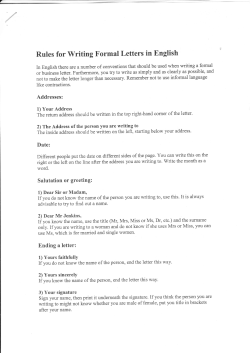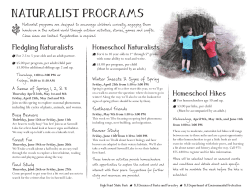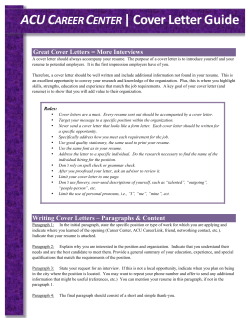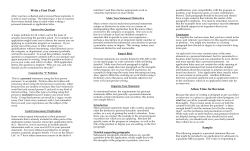
5 1 Comparison and Contrast :
Comparison and Contrast 1: Identifying Relative Clauses; Comparatives with as . . . as; Common Patterns That Show Contrast 5 U N IT Family Size and Personality 1Grammar in the Real World You will read an essay that discusses how a child’s birth order in the family – being the oldest child, middle child, youngest child, or an only child – may affect his or her personality as an adult. The essay is an example of a type of comparison and contrast writing in which the ideas are organized using the block method. ABefore You Read How many siblings (brothers and sisters) do you have? Do you think that some of their personality traits come from the order of their birth? Read the essay. How strong are the effects of birth order, according to the information in the essay? Birth Order and Adult Sibling Relationships 5 10 15 What do Jimmy Carter, Bill Clinton, and George W. Bush all have in common? In addition to being elected president of the United States, these men all share the same birth order. Each one is the oldest child in his family. In fact, many very successful people in government and business have been “firstborn” children. While there is always some variation, some experts agree that birth order can have an influence on a person's personality in childhood and in adulthood. Firstborn children often share several traits. First, in contrast to their siblings, they are more likely to be responsible, ambitious, and authoritarian. This is probably because they are born into an environment of high expectations, and they usually receive a great deal of attention. They are used to being leaders, taking responsibility for others, and sometimes taking on an almost parental role. Middle children, on the other hand, exhibit different characteristics from firstborns. They are often not as determined as firstborns. They tend to be more passive and solitary. Having to share family attention with older and younger siblings, middle children have a tendency to be more realistic, creative, and insightful. Youngest children are often more protected than their older siblings. As a result, they are more likely to be dependent and controlling. They are often as creative as middle children, but usually more easygoing and social. 64 View an e-sample of the entire book: www.cambridge.org/grammarandbeyond/sample Comparison and Contrast 1 25 A child with no siblings, or an “only child,” also exhibits some unique characteristics. While some parents worry that an only child will have difficulties socializing and making friends, studies show that, an only child is just as intelligent, accomplished, and sociable as a child with siblings. In fact, some research indicates that being an only child has some benefits. These children tend to have better vocabulary, perform better at school, and maintain closer relationships with their parents than children with siblings (Petersen, 2010). 30 Even though it is assumed that birth order dictates some personality traits, individuals can free themselves from the roles they played when they were young, but it can be difficult. According to Vikki Stark, family therapist and author of My Sister, My Self change requires letting go of familiar ways of being and patiently asserting new behaviors that express one's true self (Kochan, 2006). 20 B Comprehension Check Answer the questions. 1.How is former president Bill Clinton connected to the main idea of the text? 2.According to the writer, why are firstborn children usually more ambitious than their siblings? 3.Which of the different birth order types – first born, middle born, youngest, and only child – do you think has the fewest advantages in life? Explain. C Notice 1 Comparison and Contrast Writing Complete the outline below with information from the essay. The essay is organized using the block method. In this method, the main points that describe one part of the issue are presented together in “one block” or paragraph, and the main points that describe the second side of the issue are presented in the next paragraph, and so on. Block Method: Birth Order and Adult Sibling Relationships Introductory paragraph. Thesis statement: Some experts agree that birth order can have an influence on a person's personality in childhood and adulthood. Body Paragraph 1. Topic: Firstborn children (1) Personality traits: responsible, ambitious, authoritarian Body Paragraph 2. Topic: Personality traits: passive, solitary, Body Paragraph 3. Topic: Personality traits: dependent, Body Paragraph 4. Topic: Personality traits: intelligent, Concluding Paragraph. Topic: (2) (3) (5) (6) (8) , creative, , creative, easygoing, (4) (7) , sociable (9) (10) Family Size and Personality 65 View an e-sample of the entire book: www.cambridge.org/grammarandbeyond/sample 2 Grammar Follow the instructions below to help you notice and understand comparison and contrast sentences from the essay that use as . . . as. 1.Read the as . . . as sentence in the third paragraph. Are middle children likely to be equally determined, more determined, or less determined than firstborn children? Explain. 2.Read the as . . . as sentence in the fourth paragraph. Are youngest children likely to be equally creative, more creative, or less creative than middle children? Explain. 3.Read the as . . . as sentence in the fifth paragraph. Are only children likely be equally intelligent, more intelligent, or less intelligent than children with siblings? Explain. 3 The Writing Process Underline the sentence that gives the main idea of each body paragraph. This sentence is called the topic sentence. 2Identifying Relative Clauses Grammar Presentation A relative clause modifies a noun and follows the noun it modifies. Identifying relative clauses provide information about the noun. They are used in all kinds of academic writing, but they are especially useful in comparison and contrast writing to describe characteristics of elements that are being compared. Children who have no siblings are often very close to their parents. People gradually behave in ways which / that are more consistent with their preferred self-image. 2.1 Identifying Relative Clauses a.An identifying relative clause modifies a noun. It begins with a relative pronoun: who, whom, which, that, whose. (This is often called a restrictive relative clause.) An identifying relative clause answers the question, “Which one?” It gives necessary information about the noun or noun phrase in the main clause. Without that information, the sentence would be incomplete. identifying relative clause People who do not have children may not be aware of differences in birth order. identifying relative clause My friend who lives in Boston always remembers my birthday. b.Who, whom, and that refer to people. Use whom for object relative clauses. In informal speaking and writing, the use of who for whom is common. people Researchers who / that study families have different views. My siblings are the people in my life whom I will always trust. 66 Unit 5 C omparison and Contrast 1 View an e-sample of the entire book: www.cambridge.org/grammarandbeyond/sample Comparison and Contrast 1 2.1 Identifying Relative Clauses (continued) Whose shows possession. It is followed by an animate or inanimate noun in academic writing. Which and that refer to things. possession Researchers whose work focuses on families disagree about the importance of birth order. She cited a study whose results supported previous research. things The study examines characteristics that / which are common in firstborn children. c.In a subject relative clause, the relative pronoun is the subject in the relative clause. In an object relative clause, the relative pronoun is the object of the verb in the relative clause. Note: The relative pronoun in object relative clauses can be omitted, but it is better not to do so in academic writing. The relative pronoun may not be omitted in subject relative clauses. Psychologists who work with only children and their parents can help the children learn to share attention. (Who is the subject of the verb work in the relative clause.) There are several strategies that parents use to help their only children. (That is the object of the verb use in the relative clause.) The research (that) they just published on sibling order was inconclusive. d.A preposition can also come at the beginning of the clause, but this is only used in very formal writing. Note: The relative pronoun may not be omitted in the formal version. An older sibling is someone on whom you can always rely. more common: An older sibling is someone that / who you can always rely on. Researchers studied the ways in which parents interacted with their only child. formal writing: Data from the Real World In academic writing, 75 percent of relative clauses with whose modify inanimate nouns: The report included the results of a study funded by an organization whose mission is to help children reach their potential. 2.2 Using Identifying Relative Clauses a.Use identifying relative clauses in comparison and contrast writing to provide characteristics or information that shows the differences between the elements you are comparing. My friend who lives in Boston always remembers my birthday, but my friend who lives in New Jersey does not. Some people like to play games that involve competition, while others like to play games that encourage collaboration. Family Size and Personality 67 View an e-sample of the entire book: www.cambridge.org/grammarandbeyond/sample 2.2 Using Identifying Relative Clauses (continued) b.Relative clauses are similar to subordinate clauses: they are fragments if they appear alone. fragment: A recent study reports that firstborns are generally smarter than siblings. Who are born later. correct: A recent study reports that firstborns are generally smarter than siblings who are born later. Data from the Real World In academic writing who is much more common than that as relative pronouns for nouns that refer to people. That is more commonly used with people than who in speaking. Who That Who That Grammar Application Exercise 2.1 Identifying Relative Clauses APair Work Read the paragraph about birth order. Complete each sentence with who, whom, that, or whose. Birth order researchers have discovered some interesting information that (1) can help us understand our colleagues better. Do you have a difficult boss authoritarian personality makes (2) your life difficult? If so, your boss might be a firstborn child. Children are born first are often (3) more authoritarian than their younger siblings. Do you have a co-worker (4) is passive, but particularly creative and insightful? This person may be a middle child. People have both older and (5) younger siblings are often passive because their older siblings were responsible for their well-being when they were young. The creativity they exhibit might (6) be the effect of their having spent a lot of time on their own due to having to share parental attention with their older and younger siblings. People (8) (7) you work with are controlling may be youngest children. These people are also likely 68 Unit 5 C omparison and Contrast 1 View an e-sample of the entire book: www.cambridge.org/grammarandbeyond/sample Comparison and Contrast 1 to be more social than co-workers (9) are only generalizations. There are countless factors are middle children. Of course, these (10) help form people’s personalities, but birth order research may shed some helpful light on people’s behavior in the workplace. BLook at the relative pronouns you wrote in A. Write S above each relative pronoun that is the subject of the clause, O above each relative pronoun that is the object of the clause, and P above each relative pronoun that shows possession. Exercise 2.2 More Identifying Relative Clauses ACombine each pair of sentences that describe opinions about parental behavior using an identifying relative clause. 1.Some parents often focus too much attention on their son or daughter. These parents have only one child. Some parents who have only one child often focus too much attention on their son or daughter. 2.Parents put a lot of pressure on their children to do a lot of activities. These parents want their children to excel. 3. Children often feel a lot of stress. Their parents have high expectations of them. 4.Sports practice and music lessons are examples of activities. Some parents expect their children to do these activities after school. 5.Parents raise more independent adults. These parents give proper emotional support to their children. 6. Some children have behavioral problems at school. Their parents both work long hours. BPair Work Tell a partner whether you agree or disagree with each opinion in A. Use identifying relative clauses where possible. I don’t think it’s true that parents who have only one child focus too much attention on that child. I was an only child, and I don’t think that I received too much attention from my parents. I disagree. In my experience, parents who have an only child often want to give that child everything. The child doesn't realize what it's like to share either. Family Size and Personality 69 View an e-sample of the entire book: www.cambridge.org/grammarandbeyond/sample 3Comparatives with as . . . as Grammar Presentation Writers show similarities and differences in comparison and contrast writing by using as . . . as. Some people think that youngest children might not be as mature as their siblings. Sometimes younger children do not get as much attention as their older siblings. 3.1 As . . . as a.As . . . as can be used in the following patterns: (not) as + adjective / adverb + as (not) as + noun phrase + as adjective Youngest children are not as independent noun phrase as their older siblings. adverb An only child socializes as well as children with siblings. clause An only child has as many close friends as children with siblings. b.As . . . as can also be used to compare quantities with count and noncount nouns: (not) as much + noncount noun phrase + as (not) as many + count noun phrase + as Younger children sometimes don’t get as much attention from parents as firstborn children. Growing up as an only child has as many advantages as growing up in a large family. 3.2 Using as . . . as Use as . . . as in the following ways: to emphasize two equal elements: (just) as . . . as to show that two things are slightly unequal: almost / nearly / about / not quite as . . . as to emphasize a difference: not nearly as . . . as Only children usually turn out just as well as children from large families. Firstborn children are almost as open to new experiences as their younger siblings. Genuine concern over sibling order may not be nearly as widespread as it seems at first glance. 70 Unit 5 C omparison and Contrast 1 View an e-sample of the entire book: www.cambridge.org/grammarandbeyond/sample Comparison and Contrast 1 Grammar Application Exercise 3.1 Comparatives with as . . . as Phrases A Complete the sentences using the information in the chart and as . . . as phrases. Firstborn Children Middle Children Youngest Children Responsible Very Somewhat Not Very Social Somewhat Not Very Very Creative Not Very Very Very Realistic Very Very Not Very Dependent Not Very Not Very Very 1.Middle children firstborns. are not as responsible as (responsible) 2.Firstborn children (social) youngest children. 3.Middle children (creative) youngest children. 4.Youngest children (realistic) middle children. 5.Middle children (dependent) firstborn children. 6. Firstborn children (realistic) middle children. 7. Firstborn children (creative) youngest children. 8. Middle children (dependent) youngest children. BLook at the information in the chart in A about firstborn children, middle children, and youngest children again. Think about your birth order and the birth order of people you know. Does the information accurately describe your personality and their personalities? Why or why not? Give at least one example for each birth order. I’m a middle child and my brother is a first born child. According to the chart, I’m not as responsible as first-born children, but actually, I’m much more responsible than my brother. Maybe it’s because I was given the responsibility of taking care of everyone while my parents worked. I think I have always felt responsible for my siblings. I agree with the idea that youngest children are social. My younger brother is really outgoing and has a lot of friends . . . Family Size and Personality 71 View an e-sample of the entire book: www.cambridge.org/grammarandbeyond/sample Exercise 3.2 Comparatives with as . . . as Phrases A Listen to the story of two famous sisters – Venus and Serena Williams. Complete the chart. Serena Williams 1. Birth date 2. Height Venus Williams June 17, 1980 6'1" 3. Year turned professional 4. Wimbledon singles victories (individual years) 5. U.S. Open singles victories (individual years) BUse the information from A and the cues below to write sentences with the following as . . . as: almost as . . . as; not quite as . . . as; not nearly as . . . as; and just as . . . as. Use the negative when necessary. 1. Serena / is / tall / Venus. Serena is not as tall as Venus. 2. Serena / has / played / long / Venus. 3. Serena / is / old / Venus. 4. Serena / has / experience / Venus. 5. Serena / is / important to U.S. sports / Venus. 6. Serena / has / won / Wimbledon singles / Venus. 7. Venus / is / famous / Serena. 8.Serena / has / had / Wimbledon singles victories / Venus has had. 9. Venus / has / had / success in business / Serena. They are both successful businesswomen. CPair Work Tell a partner about two people you know well. Compare them using as . . . as structures. Next, write five sentences about them using as . . . as. Use adjectives, adverbs, and noun phrases as well as phrases such as (not) nearly, almost, and not quite as in your sentences where possible. Younsil does not have as many children as Victoria. Younsil is not quite as shy as Victoria. 72 Unit 5 C omparison and Contrast 1 View an e-sample of the entire book: www.cambridge.org/grammarandbeyond/sample Comparison and Contrast 1 4Common Patterns That Show Contrast Vocabulary Presentation Useful words and phrases that show contrast in academic writing include difference(s), differ, in contrast, and unlike. These words are important in comparison and contrast writing. One major difference in some cultures is the role of adult children. In contrast to the past, more U.S. children now live with their parents into their early adulthood. 4.1 Difference(s), Differ, In Contrast, Unlike a.A common pattern with the noun difference is: noun phrase The difference between noun phrase and is . . . b.A common pattern with the verb differ is: noun phrase noun phrase differ(s) from c.Common expressions and patterns used with the phrase in contrast are: noun phrase independent clause In contrast to , . In contrast, independent clause . d.A common pattern with the adjective unlike is: noun phrase independent clause Unlike , . One significant difference between youngest children and their older siblings is that they receive a lot of attention. The results of current research differ from earlier results. In contrast to traditional American families, Chinese families have had several generations of one-child families. Many children without siblings receive a lot of attention. In contrast, children with siblings often share their parents’ attention. Unlike some presidents' siblings, Reagan’s brother Neil genuinely liked his brother. Family Size and Personality 73 View an e-sample of the entire book: www.cambridge.org/grammarandbeyond/sample Data from the Real World Adjectives and quantifiers that most frequently occur with difference are: significant, major, important, many, large, small, some, minor, cultural, regional, individual There are many cultural differences in how parents treat their children. One major difference between the siblings is that the older ones tend to be more confident. Vocabulary Application Exercise 4.1Vocabulary of Contrast AComplete the following sentences about children in the United States using the words and phrases in the box. differ from in contrast major difference between significantly different from unlike 1.One children in the United States in 1900 and now is that children in the past didn’t get a lot of individual attention from their parents, while children today get a lot of individual attention. 2.Another way that today’s children are children in the past is that in the past, children often worked to help their families, but children now often work for their own extra spending money. 3.Today’s children also children in 1900 in that they are required to attend school. 4.Children in the past often had large families with several siblings. many children today have one or two siblings or are only children. 5.In 1900, children were very independent. today depend on their parents a lot. , them, children BPair Work With a partner, Make a chart like the one below. Write five contrasting pieces of information about children in the 1900s and now in a culture that you are familiar with. Then present your information to the class, using vocabulary from A. One major difference between young children in my native country today and in the 1900s is that in the 1900s, they used to work in factories. Today that’s illegal. Children in the 1900s Children Now 74 Unit 5 C omparison and Contrast 1 View an e-sample of the entire book: www.cambridge.org/grammarandbeyond/sample Comparison and Contrast 1 5Avoid Common Mistakes 1. Do not use who with inanimate nouns. that A study who showed the benefits of being an only child was published last year. 2. Do not omit the relative pronoun in subject relative clauses. who Children have older siblings tend to be somewhat dependent. ^ 3. Remember that the subject and the verb must agree in relative clauses. have Children who has siblings often become secure and confident adults. 4. Use the same as, not the same than. as Middle children often have the same level of creativity than last-born children. Editing Task Find and correct eight more mistakes in this body paragraph from an essay comparing trends in families in the past and today. Families Past and Present that A major way that families have changed is the number of families have only one child. The number of families had only one child was low in the United States in the 1950s and 1960s. However, one-child families began increasing in the 1970s and are very common today. This is especially true in households who have only one parent. One reason families 5 are smaller is the cost of living. It is not the same than it was 40 years ago. For example, it costs about 10 times more to send a child to college than it did 40 years ago. As a result, many parents choose to have only one child because they do not have enough money for more children. In addition, attitudes about only children are also not the same than attitudes about them in the past. In the 1950s and 1960s, people avoided having only one child. At 10 that time, many people thought that children didn’t have siblings had many disadvantages. For example, people thought that they didn’t learn good social skills. However, recent studies who focus on only children show a different picture. These studies show that only children tend to have the same social skills than children who has siblings. Family Size and Personality 75 View an e-sample of the entire book: www.cambridge.org/grammarandbeyond/sample 6The Writing Process In this section, you will write an outline and one body paragraph for a comparison and contrast essay using the block method. Before you start writing, you will learn how to write effective topic sentences. About Topic Sentences Topic sentences introduce the main idea of a body paragraph. In academic essays, they often appear at the beginning of body paragraphs. Although not all body paragraphs have topic sentences, it will help you to organize your writing if you always include one. The following guidelines will help you write effective topic sentences. 1.An effective topic sentence should contain a claim or an opinion that needs to be supported with evidence. It should not be a fact that is widely accepted as true. Notice the difference in the following sentences: •• Some families are small. (a fact) •• Small families are better than large families. (a claim that needs to be supported with evidence) 2.The content of the topic sentences should relate back to the thesis statement of the essay. •• Siblings have different personality traits because of birth order. (thesis statement) •• Firstborn children are generally leaders. (topic sentence) 3.The topic sentence is usually a general statement. It rarely contains detailed information. The details will come in the rest of the paragraph in sentences that convince the reader that the claim in the topic sentence is valid or true. •• Middle children can be more solitary. (general statement) •• Middle children do not always get a lot of attention. (detail to support the topic sentence) 4.Include words and phrases that connect one body paragraph to another. •• Unlike middle children, those born last are often more easygoing. •• In addition to being more easygoing, the youngest are also . . . •• Another common trait of the youngest children is . . . 76 Unit 5 C omparison and Contrast 1 View an e-sample of the entire book: www.cambridge.org/grammarandbeyond/sample Comparison and Contrast 1 Exercise APair Work With a partner, critique the following topic sentences that support the thesis statement below. Discuss which are strong and which are weak according to the guidelines above. Thesis statement: Being brought up in a large family has several advantages and some disadvantages. 1.One major disadvantage of growing up in a large family is that there is not much privacy. 2.When I was growing up, on the weekends my siblings and I would all go to the park and play soccer together. 3.While there are certainly several disadvantages to being part of a very large family, there are many advantages too. 4.My next-door neighbor has six siblings. 5.In a study of children growing up in large families, it was found that in 86 percent of the cases, the eldest child had the highest I.Q. BRead the following thesis statement and then write topics sentences for the body paragraphs. Use the topic given in parentheses. Thesis statement: Being an only child has several benefits: developing independence, encouraging creativity, and creating friendships outside the family. Being an only child provides many opportunities to become independent. 1.Body paragraph 1 (independence): 2.Body paragraph 2 (creativity): 3.Body paragraph 3 (friendships): Pre-writing Tasks Choose a Topic AChoose one of the essay topics listed below. You will write one body paragraph for a comparison and contrast essay on this topic. This essay will follow the block method. •• The characteristics of large and small families •• Traditions in two different families •• A topic approved by your teacher BPair Work Share your topic with a partner. Describe the similarities and differences you will write about. Family Size and Personality 77 View an e-sample of the entire book: www.cambridge.org/grammarandbeyond/sample Organize Your Ideas AFor this assignment, you will use the block method of comparison and contrast for organizing your ideas. Look at the block method outline for the essay on birth order below. Use the blank outline that follows to create an outline for your topic. Title of Essay: Birth Order Paragraph 1. Introductory paragraph. Thesis Statement: Experts agree that birth order tends to dictate some basic personality traits in children and adults. Paragraph 2. Topic Sentence: Firstborn children often share several common traits. • Traits: responsible, driven, authoritarian Paragraph 3. Topic Sentence: Middle children exhibit unique characteristics. • Traits: passive, solitary, realistic, creative, insightful Paragraph 4. Topic Sentence: Youngest children have typical characteristics as well. • Traits: dependent, controlling, creative, easygoing, social Title of Essay: Paragraph 1. Introductory paragraph. Thesis Statement: Paragraph 2. Topic Sentence: • Details: Paragraph 3. Topic Sentence: • Details: Paragraph 4. Topic Sentence: • Details: BPair Work Share your outline with a partner and discuss your ideas. 78 Unit 5 C omparison and Contrast 1 View an e-sample of the entire book: www.cambridge.org/grammarandbeyond/sample Comparison and Contrast 1 Writing Task Write one of the body paragraphs from your outline. Follow the steps below: 1.Make sure that you have a clear topic sentence that Academic Writing Tip follows the guidelines in About Topic Sentences on Improving Your Internet Searches page 76. When you do an Internet search, use 2.Include the following in your paragraph: quotation marks around important ideas. •• identifying relative clauses; For example, ”large families“ will eliminate results with only “large” or “family” alone. •• as . . . as; •• common patterns that show contrast; •• at least three of these academic words from the essay in this unit: adult, assumed, author, benefits, creative, environment, exhibit, expert, features, indicate, individual, insightful, maintain, majority, role, unique, variation. 3.After you write your paragraph, review it and make sure that you avoided the mistakes in the Common Mistakes chart on page 75. Peer Review AExchange your outline and paragraph with a partner. Answer the following questions as you read your partner’s outline and work, and share your responses. 1. Is the outline organized using the block method? 2.Does the topic sentence relate to the thesis statement? 3.Are any identifying relative clauses, as . . . as, or common patterns that show contrast used in the paragraph? 4.Is anything confusing? Write a question mark (?) next to it. 5. Provide one compliment (something you found interesting or unusual). BUse your partner’s comments to help you revise your paragraph. Use the checklist on page 000 to review your paragraph for organization, grammar, and vocabulary. Family Size and Personality 79 View an e-sample of the entire book: www.cambridge.org/grammarandbeyond/sample
© Copyright 2025









